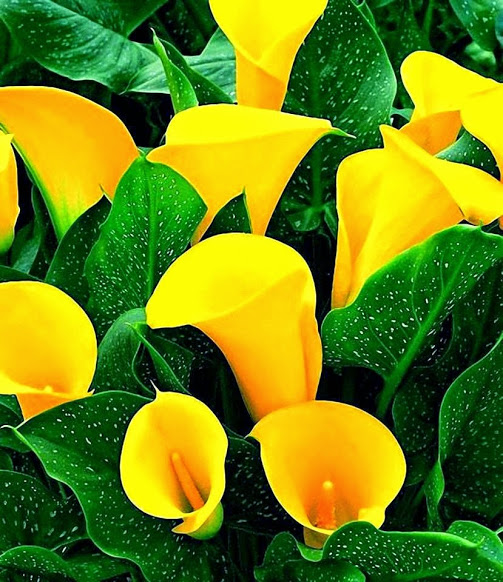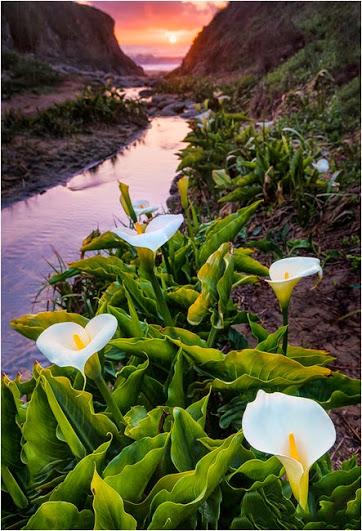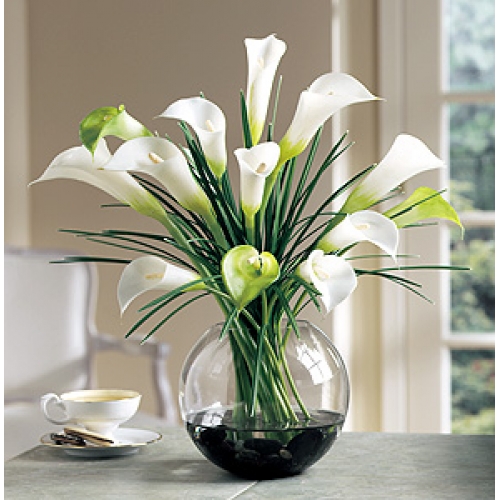Calla Lily – the magnificent bridal flower with respectable beauty is not capricious for cultivation and could be present in every home and garden. We just need to know how to plant and grow it. It is important to know that there are two varieties of the flower and there is a significant difference in their cultivation.
The Latin name for the Calla Lily is Zantedeschia, the species that gives large and lasting colours is evergreen – Zantedeschia Aethiopica. The existing hybrids of smaller colour – known as mini Calla Lily are mainly grown in pots.
The “Mini Calla Lily” as a rule, has much shorter colours than the majestic evergreen Zantedeschia Aethiopica and can be different in colour, not just white. With properly drained sandy soil and moderate sunshine, their colours could reach impressive dimensions.

Propagation is through tubers, which can be smooth or wrinkled on one side and on the other circles with small tips – the “eyes”, of which the germination of the plant actually begins. Planting is done by placing tubers about 10 centimetres into sandy soil with the “eyelets” up. Thus, the flower germinates more easily and the chance of gaining stronger colours is greater.
The best place for this is where sunshine and shade are uniform because although they relish the sun, calves need coolness for their tubers.
Ensure once the tuber has been planted that you water it moderately, too much water can cause the tuber to rot and not enough water can cause the soil to dry out. Make sure to keep the soil moist and regularly check the plant to see if it requires water.
The planting should take place in spring and the plant will bloom in the summer. It is important to know that the optimal temperature for cultivating the Calla Lily for its large colours is 18-19 degrees and at high temperatures above 25-26 degrees you should take care of the roots of the plant. You will need to isolate them with compost as overheating of the tubers is fatal and can deprive the plants colours.
Do not fertilize Calla Lily unnecessarily if it is planted in fresh soil, but if you decide to do so you will need to wait for the leaves to open and use fertilizers first.
Once in bloom, the Calla Lily keeps fresh colours for a long time and you will know when they are over-blossoming as they begin to close and turn green on the outside. In some cases browning is also observed. When blooming, the colour of the calf must be cut and allowed to make seeds. You should not cut the leaves because they provide nutrients for the tuber.
Calla Lily is a flower that rarely suffers, but if you preheat or reheat the plant, it will start rotting the tuber, which is a terrible sight, especially when the flower has already reached its beauty and majesty. When the tuber begins to rot, it is attacked by an organism in the soil called the hernium, which ruins the plant very quickly. The tuber gets a crisp-smelling consistency and the beautiful plants begin to fall.
If you doubt the rot, you could still save the plants by removing the tubers from the soil and washing them with running water, removing the rotten part. If you do this at the beginning of the process and remove the infection, there is a chance of saving the plant. It is important that after removing the rotten part (which may even include cutting) you will need to ovulate the tuber in a fungicide and dry it until the infected surfaces are covered with a crust and become stiff. Then you can plant them again, but do not pour until the first leaves appear. It is also possible to keep the tubers in a dry place and plant them next spring.

If you have grown the Calla Lily mines in the garden or in a pot, then the majestic evergreen Zantedeschia Aethiopica needs heavy marshy soil and its large white flowers appear often in the winter or early spring. Its cultivation is quite different and more difficult in the garden or at home, but in nature close to water sources with proper soil and conditions, it is extremely beautiful.

Finally, if you cannot raise Calla Lily yourself but you have bought a bouquet of these flowers, you should know that the colours are very durable and with little care can beautify your home for a long time. You will need to put them in a vase and add a little of the following mixture daily:
• 1litre – lukewarm water
• 2tsp – lemon juice
• 1ml – bleach
• 1tsp – sugar
 Happy at Home Family Problems & Solutions | Home & Health Tips
Happy at Home Family Problems & Solutions | Home & Health Tips







